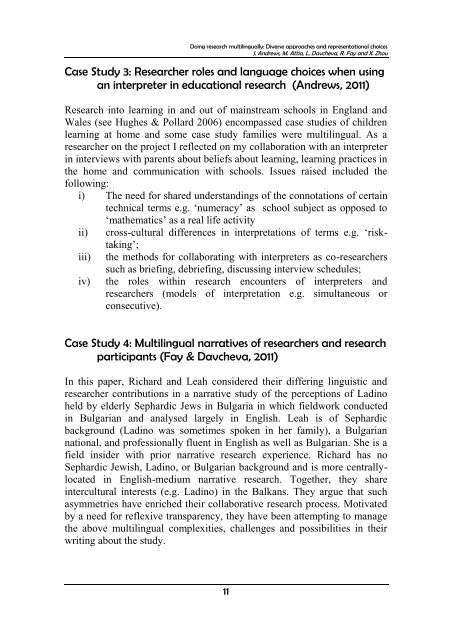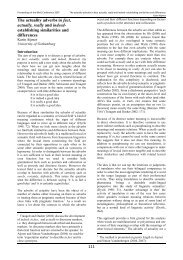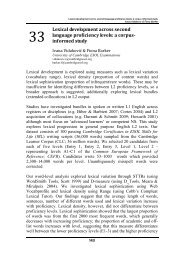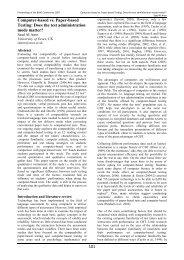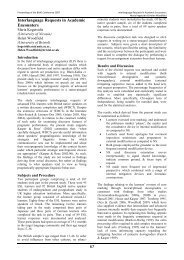Proceedings of the - British Association for Applied Linguistics
Proceedings of the - British Association for Applied Linguistics
Proceedings of the - British Association for Applied Linguistics
Create successful ePaper yourself
Turn your PDF publications into a flip-book with our unique Google optimized e-Paper software.
Doing research multilingually: Diverse approaches and representational choices<br />
J. Andrews, M. Attia, L. Davcheva, R. Fay and X. Zhou<br />
Case Study 3: Researcher roles and language choices when using<br />
an interpreter in educational research (Andrews, 2011)<br />
Research into learning in and out <strong>of</strong> mainstream schools in England and<br />
Wales (see Hughes & Pollard 2006) encompassed case studies <strong>of</strong> children<br />
learning at home and some case study families were multilingual. As a<br />
researcher on <strong>the</strong> project I reflected on my collaboration with an interpreter<br />
in interviews with parents about beliefs about learning, learning practices in<br />
<strong>the</strong> home and communication with schools. Issues raised included <strong>the</strong><br />
following:<br />
i) The need <strong>for</strong> shared understandings <strong>of</strong> <strong>the</strong> connotations <strong>of</strong> certain<br />
technical terms e.g. ‘numeracy’ as school subject as opposed to<br />
‘ma<strong>the</strong>matics’ as a real life activity<br />
ii) cross-cultural differences in interpretations <strong>of</strong> terms e.g. ‘risktaking’;<br />
iii) <strong>the</strong> methods <strong>for</strong> collaborating with interpreters as co-researchers<br />
such as briefing, debriefing, discussing interview schedules;<br />
iv) <strong>the</strong> roles within research encounters <strong>of</strong> interpreters and<br />
researchers (models <strong>of</strong> interpretation e.g. simultaneous or<br />
consecutive).<br />
Case Study 4: Multilingual narratives <strong>of</strong> researchers and research<br />
participants (Fay & Davcheva, 2011)<br />
In this paper, Richard and Leah considered <strong>the</strong>ir differing linguistic and<br />
researcher contributions in a narrative study <strong>of</strong> <strong>the</strong> perceptions <strong>of</strong> Ladino<br />
held by elderly Sephardic Jews in Bulgaria in which fieldwork conducted<br />
in Bulgarian and analysed largely in English. Leah is <strong>of</strong> Sephardic<br />
background (Ladino was sometimes spoken in her family), a Bulgarian<br />
national, and pr<strong>of</strong>essionally fluent in English as well as Bulgarian. She is a<br />
field insider with prior narrative research experience. Richard has no<br />
Sephardic Jewish, Ladino, or Bulgarian background and is more centrallylocated<br />
in English-medium narrative research. Toge<strong>the</strong>r, <strong>the</strong>y share<br />
intercultural interests (e.g. Ladino) in <strong>the</strong> Balkans. They argue that such<br />
asymmetries have enriched <strong>the</strong>ir collaborative research process. Motivated<br />
by a need <strong>for</strong> reflexive transparency, <strong>the</strong>y have been attempting to manage<br />
<strong>the</strong> above multilingual complexities, challenges and possibilities in <strong>the</strong>ir<br />
writing about <strong>the</strong> study.<br />
11


